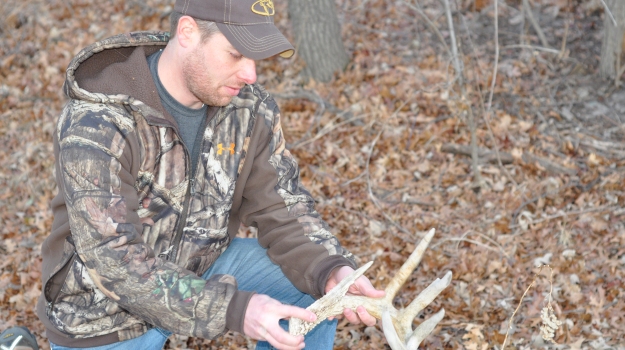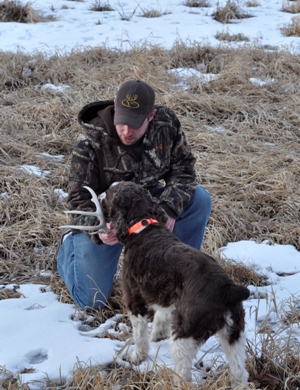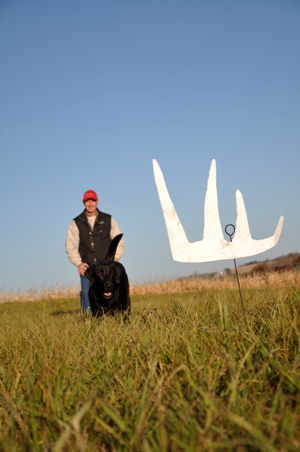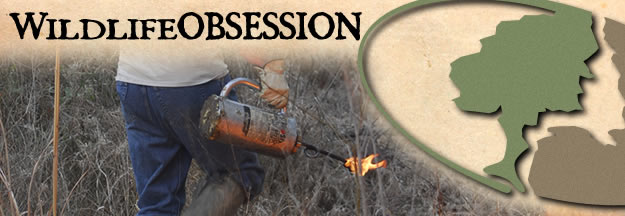
A four-legged friend can greatly increase your antler collection
By Tony J. Peterson
Late last spring I cut through a frozen swamp with my golden retriever, Lux, leading the way. As we tromped through frozen cattails, I noticed that Lux had stopped with her nose to the ground. I knew her excited tail wagging meant she had either stumbled across a fresh set of pheasant tracks or she was on an antler.
As I walked closer I could see her trying to extract a huge antler from the matted grass. The heavy side with five, bladed points scored 74 inches. Finding any antler is exciting for me but that particular antler was special. The buck had dropped it close to a ridgetop that was littered with thigh-sized rubs that had kept me up at night during the season. I figured I finally had a pretty good idea of where I’d hang a few stands for the coming season.
I did just that, keying off of the deer sign and the confirmation of the deer’s presence through his antler. Unfortunately the big deer never showed, but a good-sized nine-pointer did and I arrowed him within spitting distance of where Lux had nosed out the big shed. Some spots are just favored by big bucks and finding shed antlers can certainly clue you into hunting hotspots.
But, is it really worth it to buy a pup specifically for shed hunting?
I can’t answer that question for you because I didn’t buy a “shed dog.” I bought a bird dog and two years into it realized that I wanted to train her to find cast antlers. The process as I found, was definitely not simple but it was rewarding. Now, one of my favorite things to do is head out in the spring to walk trails and peek into deer beds with Lux leading the charge.
First Things First

If you’re interested in mixing man’s best friend with shed hunting, the first part is to choose a pup if you don’t already own a retriever of some sort. Most hardcore shedders go the Labrador retriever route for one very good reason - their retrieving instinct is so strong. However, labs are far from the only breed that will take to shed hunting. Just about any dog with the willingness to retrieve (which is just about any dog) can learn to pick up antlers.
The same goes for an existing bird dog. Lux had all of the fundamentals of discipline and upland bird hunting long before I ever introduced her to a shed antler. It took a lot of trial-and-error to teach her that antlers were a good thing and that she should not only look for them, but bring them to me after she found one.
It wasn’t until last year that I spent time with well-known dog trainer Tom Dokken that I realized how my training was on the right track, it just contained a lot of extra work that could have been eliminated.
Dokken has been at the forefront of dog training for years and is easily one of the top authorities on shed dogs. He breaks his training down into manageable segments that truly foster a canine’s natural willingness to please.
Whether you’ve got an eight-week old pup or a five-year old hunting machine, Dokken advocates a soft-sell introduction to antlers. For pups a small shed, skittered across the floor playfully will do. A slightly larger antler will work for bigger dogs, but make sure that it’s not too big. It’s natural for a dog to want to pick up bones, play with bones, and chew on bones but they don’t like getting poked in the eyes. They also don’t seem to like to pick up really big, cumbersome sheds right away. Keep it small and fun to start with.
If your dog doesn’t seem to mind prancing around with a forky shed clenched in its teeth, you can graduate them to a game of hiding sheds in the house and letting your dog look for them. Praise heavily when they find the hidden antler. You can also use treats to encourage positive behavior, but remember to include praise every time as well.
The introduction to sheds is simple enough and can occur any time you’ve got a spare few minutes in the house. The next level takes more of a commitment.
Sight & Smell
This piece of the training routine is where I stumbled. I knew my dog could smell my scent on sheds that I’d toss into the grass and that’s what she would key on. What I didn’t realize was that she was also actively looking for antlers and would sprint to anything light colored and out of the ordinary.
When I asked Dokken about this he showed me a few of the products he’s developed for his training routine. The first is Rack Wax, which mimics the waxy substance you can see on a freshly dropped antler. He believes that’s the only shed-specific scent that the dogs can key on. It can be used all over the antler at first, and then cut down to just the base after your dog makes the associate between the scent and an actual antler. To increase scent training, I used commercial scent-eliminating sprays like Scent Killer and rubber gloves to ensure that Lux wasn’t cheating and still keying on my scent. Dokken addressed this need as well with his Rack Wash.
When you’re trying to get your dog to sniff out antlers it’s important to keep expectations realistic. An antler doesn’t even compare to a living bird in terms of scent production, and it’s common for a dog to miss the scent of an antler. Do your dog a favor and work him into the wind, slowly. This provides a much greater chance of catching a whiff of an antler.

It’s easy to focus on a dog’s nose, but shed hunting requires them to use their eyes as well. Dokken has created antler silhouettes to strongly reinforce this aspect of shed dog training. He creates his silhouettes in varying sizes. At first he uses oversized silhouettes that look more like a bright white, mini-cactus than an antler. But, they are visible from a long way off and will attract a dog’s attention. Stash a real antler below the silhouette as a reward.
As the dog becomes more accustomed to using his eyes to spot tines sticking out of the grass, Dokken scales down the size of his silhouettes. He also opts for natural-toned colors for his silhouettes at this point. The entire training routine is designed to positively reinforce the fact that your dog can just as easily see an antler as smell it.
Do Sheds Matter?
Earlier I posed the question of whether it’s worth it to train a dog for sheds, but didn’t really answer it. It’s safe to assume that if you spend your spring, summer and fall spraying, cutting, planting and generally tending to food plots that you care deeply about deer and deer hunting (and probably about sheds to some extent).
For me, what started as another reason to get out and get some exercise with my dog has turned into much more. Not only is it rewarding to see my dog work, but as I illustrated earlier, finding antlers can often lead to better hunting in the fall.
I look at shed antlers the way I look at trail cameras. They can either be used simply for novelty and inventory, or they can be used to somewhat unravel the mysteries of buck behavior. If inventory is your thing, there’s nothing wrong with that. An antler provides indelible proof that a specific buck survived at least up to the date when he dropped the antler you found. That typically means he survived the majority, if not all, of the hunting season. In the case of areas with little-to-average predation this also means there’s a good chance that buck might be around next fall. If he is, there’s a high likelihood he’ll spend plenty of time in his old haunts.
If you’re interested in learning as much as you can about deer and their behavior, finding shed antlers is very valuable piece of the puzzle depending on where they’re dropped. A long-tined cast antler in the middle of your best food plot or perhaps an agricultural field might not provide too much information about a buck’s behavior because we know where deer like to feed for the most part. But, if he shakes off the other side in a bed located deep in an alder thicket, then you’ve got something to work with. The same goes for an antler dropped along a deep-woods trail or high on a wooded ridge. Although travel routes and bedding areas change with the demands of winter, finding an antler anywhere is better than not finding one at all. Sock away that location for future reference, you just never know when it will come in handy.
This can be particularly important when dealing with “surprise” bucks. Some deer may spend the entire year on your property, or within the section of land your property is located in. Others might just stop by throughout the fall in search of hot does. Some still, may show up in December to spend the winter chomping away in your food plots. Antlers from these deer will be the ones that leave you scratching your head, wondering where they came from. If a buck shows up every year in December to while away the winter months on your land, at some point you might have a bow tag left or perhaps a muzzleloader tag. That buck could just provide you with a buzzer-beater score. Finding his antlers and backtracking his habits will make it much easier to get him in shooting range.
Of course, all of this leads back to shed dogs. A well-trained canine will kick your butt in finding antlers. They are much better at sneaking through plum thickets and other nasty vegetation and will cover much more ground than you could imagine. Just think about walking a dog through a field of corn stubble. While we tend to follow a straight line covering a few rows on each side of us, a dog will sprint back and forth eating up real estate while following what his nose and eyes tell him.
If you’re interested in collecting serious bone and don’t mind the thought of a new pup, or have an existing dog that might be able to learn a new trick, consider training for shed antlers. The experience from the beginning stages of training to watching your dog sprinting back to you with an antler in his teeth is nothing short of simply awesome. Plus, that same antler might lead you to a higher taxidermy bill come fall.
Competitive Sheddin’
If you need further proof of the shed dog popularity explosion, consider the recent launch of NASHDA (North American Shed Hunting Dog Association). NASHDA is similar to field trials for bird dogs. For complete information visit www.sheddogtrainer.com.



























